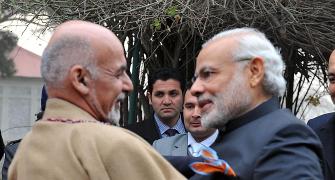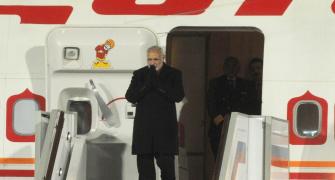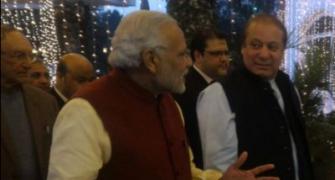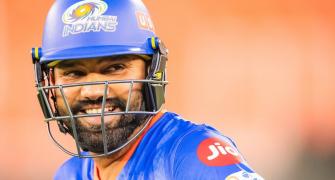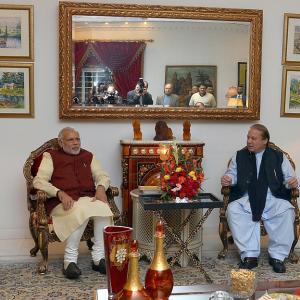Sushma Swaraj’s suave moves helped Narendra Modi pull off a diplomatic coup, helping regain her standing, reports Archis Mohan.
 The world has marvelled at Prime Minister Narendra Modi’s statesmanship and courage to drop in to wish his Pakistani counterpart, Nawaz Sharif, on his birthday in Lahore and take part in the wedding of his granddaughter. The story of Modi’s dynamic foreign policy of the past 18 months, particularly the recent India-Pak thaw, is incomplete without the enormous but unsung contribution of External Affairs Minister Sushma Swaraj.
The world has marvelled at Prime Minister Narendra Modi’s statesmanship and courage to drop in to wish his Pakistani counterpart, Nawaz Sharif, on his birthday in Lahore and take part in the wedding of his granddaughter. The story of Modi’s dynamic foreign policy of the past 18 months, particularly the recent India-Pak thaw, is incomplete without the enormous but unsung contribution of External Affairs Minister Sushma Swaraj.
Swaraj has emerged in recent months as not only Modi’s best-performing minister but one of his most trusted, while her rivals in the party find themselves embroiled in unseemly controversy. It has been a huge turnaround from July, when Swaraj, husband Swaraj Kaushal and daughter Bansuri were at the centre of allegations that they benefited from their association with former Indian Premier League czar Lalit Modi and in return, South Block helped him get his travel documents from British immigration authorities. The Opposition bayed for Swaraj’s head. The negative publicity hit her daughter, who suffered a mild stroke and was admitted to the All India Institute of Medical Sciences in mid-September.
“It was a serious blow to her morale. But, her reaction was inappropriate. She remained elusive for far too long and didn’t clarify, which dented her credibility,” says an old associate of hers. Fortunately for Swaraj, the PM stood solidly behind her.
Swaraj repaid Modi’s faith in her by being instrumental in assisting the PM score a diplomatic triumph that stunned the world for its audacity and panache. Typical of her low profile, there wasn’t a word from Swaraj that it was her rapport with Sharif and his family that contributed to the warm embrace the two PMs exchanged at Lahore’s Allama Iqbal Airport on Friday afternoon. “That’s like a statesman. Padosi se aise hi rishte hone chahiyen (That’s the kind of warm relations neighbours should have)” was all tweeted.
The circular ‘sunrise’ table at Valletta
Swaraj has worked assiduously to build good relations with Sharif and his family. In November-end, Swaraj was in Valletta, capital of the Mediterranean island-nation of Malta that hosted the Commonwealth Heads of Government Meeting, or CHOGM. There, as a South Block source recounted, the dignitaries were made to sit in the order that they receive the first rays of the rising sun.
It meant Bangladesh Foreign Minister Abul Hassan Mahmood, sat on the right of Swaraj and the Pak PM on her left. Sharif and Swaraj chatted endlessly, the source said. By the second day, the seating arrangement was changed somewhat. The Bangladeshi minister now sat at some distance from Swaraj and Sharif because of a gap in the circular table. This helped Swaraj and Sharif to talk with more ease. Swaraj’s proficiency in Urdu and Punjabi helped the conversation build up. Sharif had travelled to Valletta with his mother Shamim Akhtar, wife Kalsoom and daughter Maryam. Swaraj was invited to meet them. It helped that no journalists and camera crews from India or Pakistan were present when Swaraj broke the ice with the Sharif family.
Swaraj returned home from Malta, Kalsoom and others left for London to be present for the law exam results of Maryam’s daughter Mehrun Nisa and Sharif headed for Paris to attend the climate change talks. A day later, Sharif had an unscheduled 120-second animated discussion with Modi in Paris. The two National Security Advisors met in Bangkok on December 6, and Swaraj was in Islamabad to attend a conference on Afghanistan on December 8 and 9.
Apart from her meetings with Sharif and her Pakistani counterpart Sartaj Aziz, she again spent over four hours with Sharif’s family in Islamabad. Aziz even complemented Swaraj for her command over Urdu, confessing that in his case, his Punjabi at times interfered with his Urdu pronunciation. “Yes, subah (morning in Urdu) becomes suvere-suvere (Punjabi for morning),” Swaraj joked.
She again called on Sharif’s mother. “Tu mere watan se aayi hai, vaada kar rishte theek karke jayegi (You have come from my homeland, promise me you will try improve relations),” she told Swaraj, and spoke with nostalgia about her birthplace, Bheem ki Katra, in Amritsar.
She said neither had she visited Amritsar after Partition nor met any from her watan before Swaraj. The two spoke at length about Amritsar, a city Swaraj would visit often when growing up in her Ambala hometown and later during her political career.
Akhtar also asked about Modi and told Swaraj that the Indian PM had sent her a shawl, and asks about her wellbeing whenever speaking to her son. Swaraj also met Sharif’s wife, daughter and granddaughters. “I met four generations of the Sharif family,” she told people after returning from Islamabad.
Swaraj’s meeting with Aziz led to the decision to resume the “comprehensive bilateral dialogue”. Before returning, Swaraj met Sharif’s daughter, Maryam. “Tell your grandmother that I have kept my promise (on improving relations),” she told her.
It was mid-May 2014. Narendra Modi had won the Bharatiya Janata Party a famous victory in the Lok Sabha elections, and was being helped by Arun Jaitley, Team Modi’s brains trust and the Leader of Opposition in the Rajya Sabha, to shape his council of ministers. Swaraj, the Leader of Opposition in the outgoing Lok Sabha, wasn’t privy to the consultations.
Swaraj wasn’t sure how she would be treated by Modi and Jaitley, and was mentally prepared to be outside the government. All knew of her rivalry with Jaitley, her contemporary and one-time protege of her mentor, L K Advani. Worse was her perceived lack of communication with not just the Rashtriya Swayamsevak Sangh but also the PM-designate.
In 2013, Swaraj had stood with Advani to oppose the demand by party rank and file to elect Modi as the Bharatiya Janata Party’s prime ministerial candidate. In 2002, Swaraj had backed Atal Bihari Vajpayee when he had asked Modi to follow his “raj dharma” after the communal riots in Gujarat. It was with reluctance Swaraj accepted Modi as her leader in 2013.
Swaraj joined the Modi-led government as both the protocol she was accorded and portfolio offered were “reasonable”. It was a setback that she was number three in the government and not two. She was given the oath of office behind Rajnath Singh, her junior in both legislative seniority and experience. It could have been worse. Jaitley was sworn in at number four.
The initial months were difficult for her. Much of the credit for Modi’s dynamic diplomacy in the first few months, particularly in the neighbourhood, went to NSA Ajit Doval. Swaraj consciously kept a low profile. When she completed a year at the ministry on May 31, Swaraj told reporters that the “secret” of her success was to “keep away from the media and keep doing what you are entrusted to do”.
In the last 18 months, Swaraj has followed this principle as religiously as she coordinates the colour of her attire to that of her gemstones with the days of the week. Swaraj, who was a minister in the Haryana government in 1977, when she was only 25, doesn’t want to revive any speculation that she is a claimant in any prime ministerial sweepstake.
In 2009, Swaraj was set for a meteoric rise. She had by then for several years been the most sought after party speaker during elections, next only to the ailing Vajpayee. She fought and won the 2009 Lok Sabha elections, nearly a decade after her earlier Lok Sabha battle in 1999. That was against Congress President Sonia Gandhi in Bellary. In between, she had been a Rajya Sabha member. Swaraj learnt enough Kannada in barely a month to fluently give speeches in that language, created a party that had never really existed before in that region and lost against Gandhi from a seat that was a Congress pocket borough by a mere seven per cent votes.
“But, in 2009, her selflessness and emotional attachment to her mentor Advani cost her the chance to be the prime ministerial candidate for the 2014 elections,” an associate says. Until then, the BJP constitution had empowered the party’s leader in the Lok Sabha to appoint the leader in the Rajya Sabha. But Swaraj insisted that a special position, that of the National Democratic Alliance chairman, be created for Advani. It was Advani who was given the power to decide the leader of the Rajya Sabha.
Swaraj, an old associate of hers says, made another mistake by playing second fiddle to BJP president Nitin Gadkari. “It was because of her sense of organisational discipline. While the BJP put the Congress-led United Progressive Alliance on the mat, Swaraj failed to emerge as a national leader and an alternative to the Congress first family. Modi seized this vacuum,” the associate says.
Sent by Modi to South Block, Swaraj devoted herself to the work. Her capacity to work hard, understand complex issues, good memory and command over languages helped. She started by focusing on resolving issues like passports and visas of common people and ensuring help reached Indians in trouble abroad. She also travelled frenetically, starting with the neighbourhood.
“Her competence started being noticed by the PM when he received positive feedback during his travels abroad,” a party leader says. Swaraj only needed to pick up the threads from her time as the Leader of Opposition in the Lok Sabha. Protocol demands that the opposition leader meets all the visiting heads and this had given Swaraj enormous exposure in dealing with heads of states.
The wheel, it would seem, has come full circle for Swaraj. Her rivals find themselves under severe attack, while Swaraj has regained her standing and charisma.


